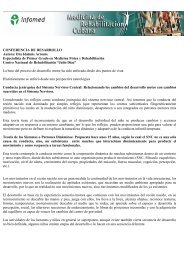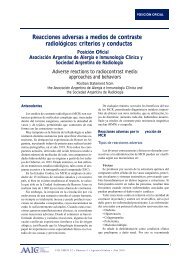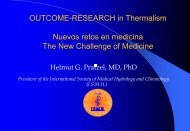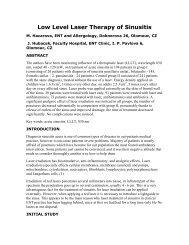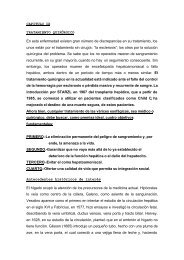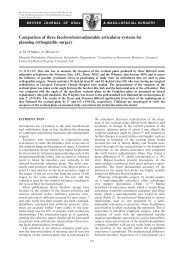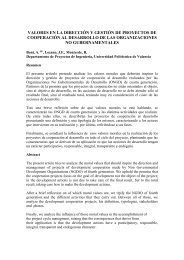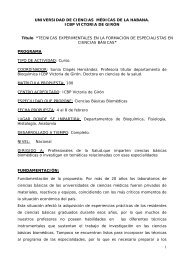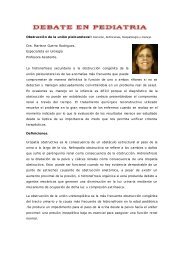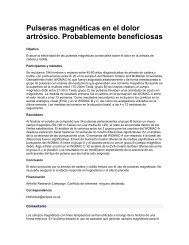pharmacology of medicinal plants and natural products
pharmacology of medicinal plants and natural products
pharmacology of medicinal plants and natural products
You also want an ePaper? Increase the reach of your titles
YUMPU automatically turns print PDFs into web optimized ePapers that Google loves.
S100<br />
S. A. DAHANUKAR et al.,<br />
Studies conducted by Rao et al, 202 have shown that<br />
pergularinine (PgL) <strong>and</strong> tylophorinidine (TPD) isolated<br />
from Pergularia pallida are potently toxic <strong>and</strong><br />
inhibit the growth <strong>of</strong> Lactobacillus leichmannii cells<br />
by binding to thymidylate synthetase. The binding led<br />
to significant inhibition <strong>of</strong> thymidylate synthetase activity<br />
making them potential anti-tumor agents.<br />
Petroleum ether extract <strong>of</strong> Hygrophilic spinosa exhibited<br />
anti-tumor activity in Ehlrich ascitic carcinoma<br />
<strong>and</strong> sarcoma 180 bearing mice 203 .<br />
Aqueous extract <strong>of</strong> Podophyllum hex<strong>and</strong>rum, a herb<br />
from the Himalayas, demonstrated significant antitumor<br />
effects when drug was tested in strain ‘A’ mice<br />
carrying solid tumors developed by transplanting<br />
Ehrlich ascites tumor cells. Radioprotective effects<br />
were also seen when the drug was administrated to<br />
mice before whole body lethal irradiation <strong>of</strong> 10 Gy 204 .<br />
The chemopreventive efficacy <strong>of</strong> Trianthema<br />
portulacastrum L.Aizoaceae was tested in male<br />
Sprague-Dawley rats. Hepatocarcinogenesis was<br />
induced by the potent carcinogen diethylnitrosoamine<br />
(DENA). Treatment <strong>of</strong> the rats with aqueous, ethanolic<br />
<strong>and</strong> chlor<strong>of</strong>orm fractions <strong>of</strong> the plant extract at a dose<br />
<strong>of</strong> 100 mg/kg once daily reduced the incidence, numerical<br />
preponderance, multiplicity <strong>and</strong> size distribution<br />
<strong>of</strong> visible neoplastic nodules. Morphometric<br />
evaluation <strong>of</strong> focal lesions showed a reduction in<br />
number <strong>of</strong> altered liver cell foci per square centimeter<br />
as well as <strong>of</strong> average area <strong>of</strong> individual lesion. A decrease<br />
in the percentage <strong>of</strong> liver parenchyma occupied<br />
by foci seems to suggest the anti-carcinogenic<br />
potential <strong>of</strong> the plant extract in DENA-induced<br />
hepatocarcinogenesis 205 .<br />
Pretreatment with Ocimum sanctum leaf extract followed<br />
by the addition <strong>of</strong> 7,12-dimethylbenz[a]anthracene<br />
(DMBA) significantly blocked the formation<br />
<strong>of</strong> DMBA-DNA adducts in primary cultures <strong>of</strong> rat<br />
hepatocytes in vitro. The viability <strong>of</strong> the cells was not<br />
adversely affected by the extract 206 .<br />
17. Immune active <strong>plants</strong><br />
Modulation <strong>of</strong> the immune response through stimulation<br />
or suppression may help in maintaining a disease<br />
free state. Agents that activate host defence<br />
mechanisms in the presence <strong>of</strong> an impaired immune<br />
responsiveness can provide supportive therapy to<br />
conventional chemotherapy. Upadhyay 207 has high-<br />
lighted the therapeutic potential <strong>of</strong> immunomodulatory<br />
angets from plant <strong>products</strong>. They have evaluated<br />
Indian <strong>medicinal</strong> <strong>plants</strong> for immunomodulatory<br />
activity 208 . The authors have also reviewed the<br />
Ayurvedic concepts <strong>of</strong> preventive health care. A list<br />
<strong>of</strong> Ayurvedic <strong>medicinal</strong> <strong>plants</strong> showing immunomodulatory<br />
activity has been provided which includes<br />
agents like Withania somnifera, Allium sativum,<br />
Azadirachta indica, Piper longum, Asparagus<br />
racemosus, Glycyrrhiza glabra, Aloe vera, Gmelina<br />
arborea <strong>and</strong> Tinospora cordifolia.<br />
Thatte <strong>and</strong> Dahanukar, 209 have described how clues<br />
from the description <strong>of</strong> ancient writings can lead to<br />
the development <strong>of</strong> new immunostimulatory agents.<br />
The experiments carried out to prove the rasayana<br />
concept <strong>of</strong> Ayurveda have demonstrated that Asparagus<br />
racemosus, Tinospora cordifolia <strong>and</strong> Withania<br />
somnifera protected animals against infections in<br />
normal <strong>and</strong> immunosuppressed states induced by<br />
hemisplenectomy or surgery 210 . These <strong>plants</strong> also<br />
produced leucocytosis with predominant neutrophilia<br />
<strong>and</strong> prevented, to varying degrees, the leucopenia<br />
induced by cyclophosphomide. They were found to<br />
activate the polymorphonuclear <strong>and</strong> monocyte-macrophage<br />
systems. Only those rasayanas which produced<br />
sweet (madhur) vipaka (Tinospora cordifolia,<br />
Asparagus racemosus, Emblica <strong>of</strong>ficinalis, Terminalia<br />
chebula <strong>and</strong> Withania somnifera) were found to<br />
stimulate the reticulo-endothelial system, but not<br />
those like Acorus calamus, Commiphora mukul <strong>and</strong><br />
Picorrhiza kurroa, which produced bitter (katu)<br />
vipaka 210 .<br />
Among the immunostimulant rasayanas, Tinospora<br />
cordifolia has been extensively studied by Dahanukar<br />
et al 211 . It has been found to activate the mononuclear<br />
cells to release cytokines like GMCSF 212 <strong>and</strong><br />
IL-1 in a dose dependent manner 210 . Whole aqueous<br />
extract <strong>of</strong> Tinospora cordifolia, st<strong>and</strong>ardized using<br />
HPTLC, has been evaluated as an adjuvant in<br />
clinical conditions like obstructive jaundice, tuberculosis<br />
<strong>and</strong> cancer chemotherapy <strong>and</strong> has been found<br />
to increase the efficacy <strong>of</strong> conventional therapy 210 .<br />
Active principles <strong>of</strong> Tinospora cordifolia were found<br />
to possess anticomplementary <strong>and</strong> immunomodulatory<br />
activities. Syringin (TC-4) <strong>and</strong> cordiol (TC-7) inhibited<br />
the in vitro immunohaemolysis <strong>of</strong> antibody -<br />
coated sheep erythrocytes by guinea pig serum<br />
by inhibiting the C3-convertase <strong>of</strong> the classical




